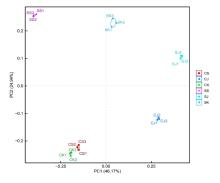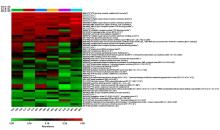| 1 |
宋顺佳,王鑫莹,姜菲菲,等.幽门螺杆菌对克拉霉素、甲硝唑和左氧氟沙星的耐药率及其相关耐药基因突变特征[J].吉林大学学报(医学版),2022,48(3):630-637.
|
| 2 |
袁 伟,黄永坤.儿童幽门螺杆菌感染与肠道菌群研究进展[J].国际儿科学杂志,2021,48(10):671-675.
|
| 3 |
KATAOKA K. The intestinal microbiota and its role in human health and disease[J].J Med Invest,2016,63(1/2):27-37.
|
| 4 |
SENDER R, FUCHS S, MILO R. Are we really vastly outnumbered? revisiting the ratio of bacterial to host cells in humans[J].Cell, 2016, 164(3): 337-340.
|
| 5 |
JANDHYALA S M, TALUKDAR R, SUBRAMANYAM C, et al. Role of the normal gut microbiota[J].World J Gastroenterol,2015,21(29):8787-8803.
|
| 6 |
GHOSH S, WHITLEY C S, HARIBABU B, et al. Regulation of intestinal barrier function by microbial metabolites[J].Cell Mol Gastroenterol Hepatol,2021,11(5):1463-1482.
|
| 7 |
汪韦宏,梁晨晨,张发明.肠道菌群重建在肿瘤治疗中的研究进展[J].中国肿瘤,2022,31(4):292-300.
|
| 8 |
黄 宏,肖 珉,邹 冲,等.基于“心-脑-肠轴”理论概述肠道菌群与难治性高血压的发病[J].中华中医药杂志,2021,36(8):4809-4811.
|
| 9 |
王 绘,张琳琳,高 玮,等.达格列净对初诊2型糖尿病患者胰岛β细胞功能及肠道菌群的影响[J].中华糖尿病杂志,2022,14(4):337-344.
|
| 10 |
彭 越,贺迎坤,王丽丽,等.不同病程老年帕金森病患者肠道菌群和血清氨基酸水平的变化[J].中华老年医学杂志,2021,40(2):153-157.
|
| 11 |
SOCAłA K, DOBOSZEWSKA U, SZOPA A,et al.The role of microbiota-gut-brain axis in neuroPsychiatric and neurological disorders[J].Pharmacol Res,2021,172:105840.
|
| 12 |
TAO Z H, HAN J X, FANG J Y. Helicobacter Pylori infection and eradication: exPloring their imPacts on the gastrointestinal microbiota[J].Helicobacter,2020,25(6): e12754.
|
| 13 |
唐华英,叶广彬,韦红玉,等.广西百色市慢性胃炎患者胃黏膜菌群特征研究[J].扬州大学学报(农业与生命科学版),2021,42(4):29-33.
|
| 14 |
WROBLEWSKI L E, PEEK R M. Helicobacter pylori, cancer, and the gastric microbiota[J]. Adv ExP Med Biol,2016,908:393-408.
|
| 15 |
JOSE P A, MAHARSHI A, JHA B. Actinobacteria in natural products research: progress and prospects[J]. Microbiol Res,2021,246:126708.
|
| 16 |
UNDABARRENA A, PEREIRA C F, KRUASUWAN W,et al. Integrating perspectives in actinomycete research:an actinobase review of 2020-21[J]. Microbiology (Reading),2021,167(9):001084.
|
| 17 |
CHEN C C, LIOU J M, LEE Y C,et al. The interPlay between Helicobacter Pylori and gastrointestinal microbiota[J].Gut Microbes, 2021,13(1):1-22.
|
| 18 |
MARTINEZ-GURYN K, LEONE V, CHANG E B. Regional diversity of the gastrointestinal microbiome[J].Cell Host Microbe, 2019,26(3):314-324.
|
| 19 |
YIN Y N, WANG C L, LIU X W, et al. Gastric and duodenum microflora analysis after long-term Helicobacter Pylori infection in Mongolian Gerbils[J].Helicobacter,2011,16(5): 389-397.
|
| 20 |
SELGRAD M, BORNSCHEIN J, ROKKAS T, et al. Helicobacter Pylori: gastric cancer and extragastric intestinal malignancies[J]. Helicobacter,2012,17: 30-35.
|
| 21 |
SCHUBERT M L.Gastric secretion[J].Curr Opin Gastroenterol, 2010, 26(6):598-603.
|
| 22 |
HUSEBY E S, WHITE J, CRAWFORD F, et al. How the T cell repertoire becomes peptide and MHC specific[J].Cell,2005,122(2): 247-260.
|
| 23 |
YAKOOB J, ABBAS Z, NAZ S, et al.Virulence markers of Helicobacter Pylori in patients with diarrhoea-dominant irritable bowel syndrome[J].Br J Biomed Sci, 2012,69(1): 6-10.
|
 ),Ganrong HUANG1,Huaying TANG1(
),Ganrong HUANG1,Huaying TANG1( ),Yuanyuan DAI1
),Yuanyuan DAI1

















